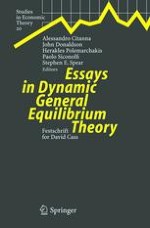2005 | Buch
Essays in Dynamic General Equilibrium Theory
Festschrift for David Cass
herausgegeben von: Professor Alessandro Citanna, Professor John Donaldson, Professor Herakles Polemarchakis, Professor Paolo Siconolfi, Professor Stephan E. Spear
Verlag: Springer Berlin Heidelberg
Buchreihe : Studies in Economic Theory
